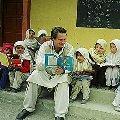Greg Mortenson looks like a typical climber, wearing frayed khakis, a tan top and only socks on his feet – no pretensions whatsoever as he addresses about 400 people packed into a Denver area bookstore.
------- Using slides, he tells the story detailed in his book about climbing K2, the world's second tallest peak, which straddles the Pakistan-China border. In 1993, Mortenson came within hundreds of meters of the summit where he planned to honor his late sister.
But an illness forced the California nurse and his climbing party to descend. A devastated Mortenson got lost on the way down and stumbled, emaciated, into a Pakistani village, where locals nursed him back to health.
On a chilly fall day, he asked about the village's school, "They were very embarrassed and reluctant but finally they took me behind the village where I saw 84 children sitting in the dirt, doing their school lessons. Most of the children were writing with sticks in the sand." Mortenson grew up in Africa on the slopes of another famous peak, Mount Kilimanjaro.
His father founded a hospital and his mother an international school. Mortenson had seen poverty, but the children in the village of Korphe tugged at his heartstrings.
"So when a young girl named Chocho came up to me and said, 'It is very cold here. Could you help us build a school?' I made a very rash promise that day. I said, 'I promise that I'll build a school for you.'" A school was built.
Educating girls and young women is the focus, since men often leave the community for work.
Mortenson says literate women are already helping to improve the health and quality of life of villagers. He also considers education the best weapon against terrorism and the influence of Islamic militants.
Longtime friend Christine Leitinger, who helps raise money for the schools, says Mortenson's humility and quiet ways help sell his mission. "He's not a superhero. He's a real human being, he struggles with things. And a lot of times when we create superheroes, it feels too untouchable. We can't reach that status. But when we have someone who is heroic but human, we can tap that heroism in ourselves." Mortenson ignored two fatawa that prohibited him, as a non-Muslim, from encouraging education. In both cases, local Islamic clerics came to his defense. Other leaders helped in other ways. Mortenson recalls his frustration after spending three years trying to build the first school.
"I was doing something that we know of as micromanagement here in America. Well, one day the old village chief Haji Ali, he took me behind the school. He said, 'Son, we're grateful for what you've done but you've got to sit down and be quiet.'" Mortenson looks at the crowd and adds with a chuckle, "He used a lot harsher words than I could say here." Six weeks later, the school was built, thanks to the locals' involvement. The importance of working together inspired his book's title. Sharing three cups of tea made Mortenson and the villagers 'family'. Mortenson signs the books of every fan standing in a line that weaves around the bookstore. Many in the crowd of mostly older women say Mortenson showed them that they could be philanthropists, even with modest incomes. After all, a penny will buy a pencil. Joyce Trygstad Nelson says it to a chain reaction.
"The power of one person. The power of a message to spread through a community. The connections from one community to another and what that can do to help people in a place where most of us have never been and will never get to." Trygstad Nelson has spearheaded seminars at her church about Mortenson's educational efforts. Meanwhile, Mortenson, a Montana resident, spends at least half the year in Central Asia building schools. He says he no longer climbs. "After K2, I guess I found a far greater mountain to climb. And that's helping with the people and dedicating my life to education."

